
Antarctica overall has cooled measurably during the last 35 years – despite a global average increase in air temperature of 0.06 degrees Celsius during the 20th century – making it unique among the Earth’s continental landmasses, according to a paper published today in the online version of Nature.
Researchers with the National Science Foundation (NSF) Longterm Ecological Research (LTER) site in Antarctica’s Dry Valleys – a perpetually snow-free, mountainous area adjacent to McMurdo Sound – argue in the paper that long-term data from weather stations across the continent, coupled with a separate set of measurements from the Dry Valleys, confirm each other and corroborate the continental cooling trend.
“Our 14-year continuous weather station record from the shore of Lake Hoare reveals that seasonally averaged surface air temperature has decreased by 0.7 degrees Celsius per decade,” they write. “The temperature decrease is most pronounced in summer and autumn. Continental cooling, especially the seasonality of cooling, poses challenges to models of climate and ecosystem change.”
The findings are puzzling because many climate models indicate that the Polar regions should serve as bellwethers for any global warming trend, responding first and most rapidly to an increase in temperatures. An ice sheet many kilometers thick in places perpetually covers almost all of Antarctica.
Peter Doran, of the University of Illinois at Chicago, the lead author of the paper, and his co-authors, acknowledge that other studies conducted in Antarctica have deduced a warming trend elsewhere in the continent. But they note that the data indicate that the warming occurred between 1958 and 1978. They also note that the previous claims that Antarctic is warming may have been skewed because the measurements were taken largely on the Antarctic Peninsula, which extends northwards toward South America. The Peninsula itself is warming dramatically, the authors note, and there are many more weather stations on the peninsula than elsewhere on the continent.
Averaging the temperature readings from the more numerous stations on the Peninsula has led to the misleading conclusion that there is a net warming continent-wide. “Our approach shows that if you remove the Peninsula from the dataset, and look at the spatial trend. The majority of the continent is cooling,” said Doran.
He added that documentation of the continental cooling presents a challenge to climate modelers. “Although some do predict areas of cooling, widespread cooling is a bit of a conundrum that the models need to start to account for,” he said.”
The Dry Valleys are the largest ice-free area in Antarctica, a desert region that encompasses perennially ice-covered lakes, ephemeral streams, arid soils, exposed bedrock and alpine glaciers. All life there is microscopic.
The team argues that the cooling trend could adversely affect the unique ecosystems in the region, which live in a niche where a delicate balance between freezing and warmer temperatures allows them to survive and where liquid water is only available during the very brief summer. They argue that a net cooling of the continent could drastically upset that balance.
“We present data from the Dry Valleys representing the first evidence of rapid terrestrial ecosystem response to climate cooling in Antarctica, including decreased lake primary productivity and declining soil invertebrates,” they write.
Their data, they argue, are “the first to highlight the cascade of ecological consequences that result from the recent summer cooling.”


















Comments are closed.